#big cat sanctuary
Text
Snow leopards of the Big Cat Sanctuary in the UK. They love to cuddle when they sleep.
7K notes
·
View notes
Text

Laila with her first and only daughter, Zaya. Photographed by Alma Leaper at Big Cat Sanctuary, Kent, England.
506 notes
·
View notes
Text
Jaguars @thebigcatsanctuaryuk
118 notes
·
View notes
Text
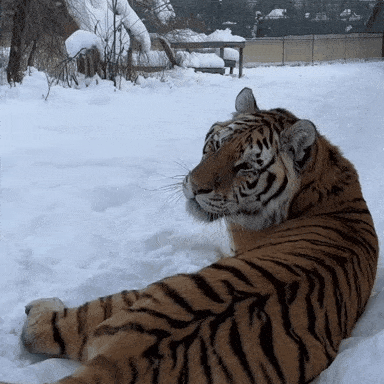
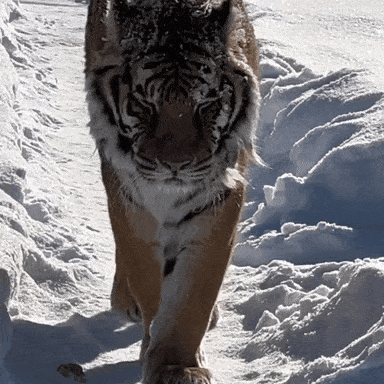

❄🐅 Tigers in the snow 🐅❄
#stims#stimboard.#stimboard#'stimboard'#my gifs#tiktoks#animals#tiger#tigers#snow#winter#big cats#big cat sanctuary
134 notes
·
View notes
Text
0 notes
Text
You need to hear this 🗣 🎶
[Cheetahs aren't "big cats" (under the genus panthera) so they aren't capable of roaring unlike other larger wild cats you may be familiar with]
#cheetah#animals#nature#wildlife#cheetahs#wild animals#big cats#beautiful animals#beautiful animal#animals video#cats#feline#cute cats#animalsanctuary#animal sanctuary#wild life
3K notes
·
View notes
Text
To continue the theme of "wtaf is up with that sanctuary that feeds bears Twizzlers and camels Mountain Dew", here's another recent social media post I find rather concerning. Who the heck is giving cheetah - vulnerable animals with a very small population - to a sanctuary that is rabidly, openly anti-zoo and anti-conservation breeding?

The reason this stands out to me so much is that there just like... are not cheetah in sanctuaries in the US. Most cheetah in the US are part of a breeding program, either AZA's SSP or ZAA's AMP - it's not common to find them in even unaccredited zoos, much less newly moved to sanctuaries. Of the 400-some cheetah I found doing the big cat census in 2020, there were less than 10 in facilities that branded themselves as sanctuaries. So where did these cats come from?
What's more, okay, there's no trace of these ladies on social media before now. The Wild Animal Sanctuary is normally very open about their acquisitions, and no facility they've gotten animals from since their last USDA inspection has had cheetah. I haven't heard about any imported cheetah recently either, which is another thing you can check for this facility, because the majority of their rescues are imported from all over the world.
There's another weird thing about this post, too. Look at the language. It's all very "here's a cheetah! they're very happy outdoors in their nice habitat." And if you're not facility with this institution and their messaging, you might not catch why that's odd. This facility emphasizes, in every post they can, that their animals are rescued from horrible no-good very-bad abusive situations. Normally they name and shame if they can, or talk about how they came from the cub petting industry or private exploitation or such. There's none of that in this post, and it stands out because of it - especially because it's the first time these very rare, very charismatic big cats are being shared with their audience.
So where the heck did these cats come from?
Whelp.
Turns out the answer is AZA-accredited zoos. And whew, man, does that raise some questions.
Luckily these girls have some pretty distinctive names, so I was able to find them in the international and regional cheetah studbooks pretty easily. For both cats, the most recent listing in the studbooks was at AZA-accredited zoos in Texas: in 2020 Dahlila was living at Caldwell Zoo, and in 2022 Jaina was at Fossil Rim Wildlife Center.
Now, we don't know for sure that Caldwell and Fossil Rim are the facilities that chose to dump their cheetah in a sanctuary. There's some important context to know about exotic animal ownership and how animals leave AZA SSPs. General practice is that large charismatic mammals aren't bought and sold at AZA zoos, especially SSP animals, so animals sent out to other facilities for breeding or exhibition are moved around on loan. Sometimes their ownership changes with the transfer, but not always - it really depends on the species and how much control each facility wants to have over their animals. On top of that, the ownership of offspring sometimes alternates by litter or individual between the institutions that own the parents. When they're part of a cooperative breeding program none of that matters very much because all the animals are managed as a single population and moved as required for breeding and to fill empty display spaces. Where it's relevant is when an animal is removed from the SSP population - at that point it's totally up to the facility that owns it to choose where they live, as long as they send them somewhere AZA agrees is providing a reasonable standard of care. (This will be important in a little bit.)
So what we can tell from this situation is that Jaina and Dahlila were, for some reason, probably excessioned from the SSP in the last couple years. And whichever AZA facilities owned them decided to send them to The Wild Animal Sanctuary instead of finding a display-only placement at a zoo or safari park or similar facility.
Since I started writing this post, TWAS confirmed the origin of these girls in a Facebook comment.

I have real concerns about what appears to be an emerging trend of exotic animal exhibition facilities using sanctuaries as a "dumping ground" for their elderly or extra animals, in order to prioritize space for breeding or more desirable animals. I can't prove it yet, but there's been just enough weird transfers to have caught my attention. (In some cases, there's a good reason - sometimes all the habitats designed for the physical needs of elderly animals of a certain species already are full, and it's better for them to go somewhere they can exist more easily rather than trying to retrofit their current habitat - but it isn't every case). And here's the thing: many sanctuaries, like TWAS, message about how they have to exist to take all the discards from the zoo industry. In recent years that hasn't really been accurate, and historically, it did happen but not as commonly as it's portrayed. So... if that's true... and it's a bad thing... why are sanctuaries encouraging it by taking the animals zoos are transferring out to free up space? You'd think they'd want to say "find space in your own institutions and only call us if there's a crisis." (Money. The answer is money. Every new intake is used for marketing and drives additional donations.) Heck, why are zoos playing into that narrative, when they're frequently rebutting attacks claiming they discard the animals that aren't useful or aesthetic anymore?
All of this actually makes a lot of sense given how short on space all the AZA SSP programs are. Both in general, and for big cats, there are not enough spaces across accredited zoos to hold all the animals needed for sustainable populations. (This is why AZA just recently re-imagined their SSP programs, which is a whole other complicated mess that I am working on a writeup about). Recent political shifts within AZA corporate leadership have also discouraged collaborations between AZA-accredited zoos and non-AZA facilities, so while 20 years ago it would have been fine to move extraneous / non-breeding cats to smaller unaccredited facilities for display, that's less of an option. Which leaves sanctuaries as kind of the only politically appropriate option. This would also explain why the text of the post is so weird: there's probably a contract in place to prevent using their images to bash zoos.
The problem with sanctuaries as a solution for housing extra animals is, well, the quality of care they provide. If you haven't seen me say it before: sanctuaries are as varied in their expertise and function as zoos. In the case of The Wild Animal Sanctuary (and their other facilities, like the Refuge these cheetah are at) everything I have learned about them indicates that their animal care is highly questionable. Which is a problem, because - as mentioned earlier - AZA-accredited facilities are required to follow a responsible population management policy, which means ensuring that animals they send outside of AZA go somewhere that gives them high-quality care.

TWAS is an organization that prefers to feed big cats at multiple facilities frozen meat puree "frisbees" by chucking them over the fence. They don't have any way to separate co-housed cats to prevent conflict during feeding or resource guarding, because they don't build their enclosures with any sort of shift or lock-out areas. It's also unclear how they remove food waste without a way to shift animals out to go find it. (For bears they drive in on a truck into the habitat and then go on foot to clean, but I don't know if that's done with the big cats once they’ve been released from quarantine pens.
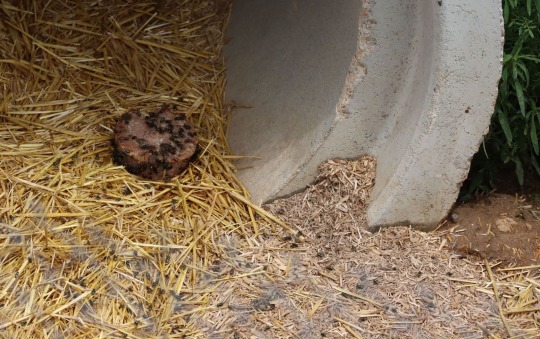
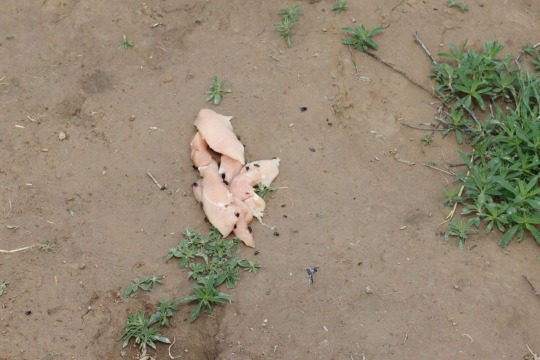
(These are my photos of food in carnivore habitats at TWAS this summer. Given the pest accumulation on the meat frisbee and the fact that I visited early in the day, it seems probable it was at least a day old.)
This is an organization that is ethically against training their animals for any reason: it's literally written into their statement of purpose as a “true sanctuary.” It's also described below, in a recent book published about the facility.

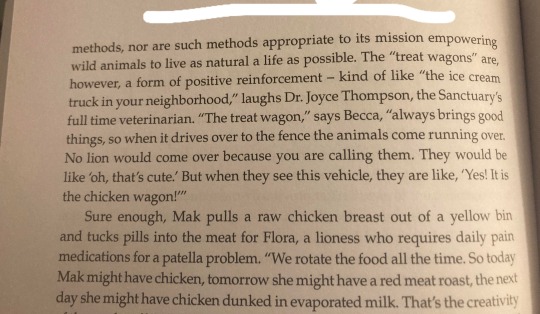
That policy means these cheetahs will not have a recall behavior, will not be trained for medical examinations or as a way to lower stress for procedures, and will not get the mental enrichment and interaction they're used to from regular training sessions. According to the book, medications are delivered on a long spoon / tongs tucked inside the cat equivalent of a pill pocket. (Which anyone with a pet cat knows falls apart as a plan if they're sick enough to not feel hungry).
I'm pretty sure there's no heated shelter for the large carnivores or bears at TWAS. The main shelter for animals at the Sanctuary is single-entrance concrete culverts buried underground far enough they're supposed to maintain a constant temperature all winter.

Sounds nice in theory, but with no second exit animals can get trapped down there, and there's no way to monitor them when they're inside. I don't know what type of shelter the Refuge provides, but it probably isn't much different. Even the quarantine spaces - smaller outdoor kennel-type pens with three exposed mesh panel walls - have no heat, and just an above-ground culvert block for them to curl up in. While cheetah are surprisingly adaptable to cold weather, winters in Colorado can be very harsh for prolonged periods of time.
As far as I know, most of the animals at facilities TWAS runs don't get regularly changed, novel enrichment. I've certainly never seen much in the habitats other than climbing structures when I've visited their main facility over the years, and most of their messaging around “toys” is semi-permanent furniture like giant telephone wire spools or a suspension bridge for climbing. I think some of the bears get balls? The messaging from TWAS is that their animal care is better because it's close to a natural life in the wild. Animals can be animals! When returned to their wild roots, animals shouldn't need anything from humans and are happier that way, etc.
When animals come to the Sanctuary (or the partner facility, the Refuge) they're literally chucked into a big fenced-off piece of land and left out there to "be cats" without human interaction except for feeding time and observations. Which is the polar opposite of what these cheetah are used to! AZA cheetahs, even those that aren't program animals, are intensely managed. They're used to regular human contact, frequent training, and constant enrichment. So what's "normal" for a wild cat is a far cry from what these cheetah girls have always known. That's not better - that's a loss of quality of life.
I don't understand how moving animals to places like TWAS is in line with AZA's Responsible Collection Management policy. I don't understand how AZA facilities think the type of husbandry the facility describes providing is acceptable. If another zoo utilized half the same care practices, they'd be drawn and quartered by their industry peers as well as by the public - and rightfully so. I don't understand why anyone wants to send animals there, based even just on what's easily observable. I don't have more information or really a conclusion, just that’s what's observable from an external vantage point is upsetting as heck and I worry for those cheetah girls.
#big cats#cheetahs#animal welfare#sanctuary politics#zoo industry politics#animal care#AZA#long post#this originally said cheetah are highly endangered which was a fact checking error#updated it to reflect that#bug tw
1K notes
·
View notes
Text
Headcanon that post-canon Caleb has never actually adopted a cat himself. Rather, his friends are regularly gifting him a never-ending stream of cats, which over the years has included:
Schatz, a little munchkin cat from Veth, who delights in taking and hiding little trinkets around the house. Many inkpots (not always empty), jacket buttons, and Dynasty-style earrings have been claimed for Schatz’ secret hoards over the years and she has no intention of stopping.
Dashilla, a gangly rescue cat with one eye from Jester and Fjord. She appeared on their ship one day after they left port in Port Damali, and her favourite person in the entire world is Fjord. They couldn’t keep her for allergy reasons, hence why she is now biting Caleb’s hand whenever he lets his guard down.
A fully grown moorbounder named Blümchen from Yasha, who bought her as a mount during a stopover in Asarius and really bonded with her. Yasha returned home to Zadash with her; when the fantasy HOA objected, Beau joked that they should give Blümchen to Caleb and Yasha fully committed to the bit.
Charly, an absolutely enormous Norwegian forest cat which Caduceus found in the Savalirwood. Spends his days climbing up to the roof to sunbathe and menacing all rodent lifeforms who so much as twitch a whisker in the cottage’s direction.
Motherfucker, a spotted cat from Beau. Her name was originally going to be Professor, but Beau called her Motherfucker so much that it’s the only thing she responds to now. Was found abandoned behind the Beaurebar one evening, and is the most affectionate cat in the world to everyone except for Beau (hence the name). Also nicknamed “Pop Pop” because one simply cannot tell visitors that one’s cat is named Motherfucker.
A whole entire litter of kittens, also from Jester and Fjord, from a ship’s cat on a Stone’s Throw ship. Their names are Brötchen, Pumpernickel, Knödel, Pfeffernüsse, and Spritzkuchen, and they came with a basket of the best (slightly stale) pastries from around the Lucidian Ocean.
Kaiser, the most regal stray that the streets of Darktow have ever produced. Kingsley claims that the large roguish scar on his cheek is from Kaiser and that he needs someone to take this hellcat off his hands. It would probably be more believable if Kaiser weren’t the laziest tyrant to ever claim the cat basket for himself.
Hansel and Gretel, separate presents from Astrid and Eadwulf respectively. Hansel is both an apology and a bribe from Astrid for making Caleb the student counsellor at the Academy. No explanation was given for Gretel, Eadwulf just knocked on his door one day, dumped a yowling tabby in Caleb’s arms, and left without saying anything.
Perle, a pure white cat who technically belongs to Essek. Technically. It’s just that he’s always on the move trying to avoid capture by both the Dynasty and the Empire, and he would really appreciate it if someone could look after his cat for him until things are a little safer? Of course he would have to visit often to check in on Perle, and maybe his Zemnian friend too while he’s at it.
#critical role#caleb widogast#the mighty nein#not all of the cats overlap at the same time because caleb's cottage is only so big even with magic#he had to build a special stable for blümchen in the garden and keeping them all inside is a bigger challenge than spell creation#caleb's cat sanctuary: a seventh level spell that sets a magical boundary around a given area which cats cannot cross
506 notes
·
View notes
Text

" Luka " //© Dan
#Big Cats Sanctuary#England#United Kingdom#nature#landscape#Portraits#Wildlife#Amur Leopard#aesthetics#wanderlust#explore#follow#discover
85 notes
·
View notes
Text
10 notes
·
View notes
Text
Snow leopards Jesse and Panja at the big Cat sanctuary in the UK.
393 notes
·
View notes
Text

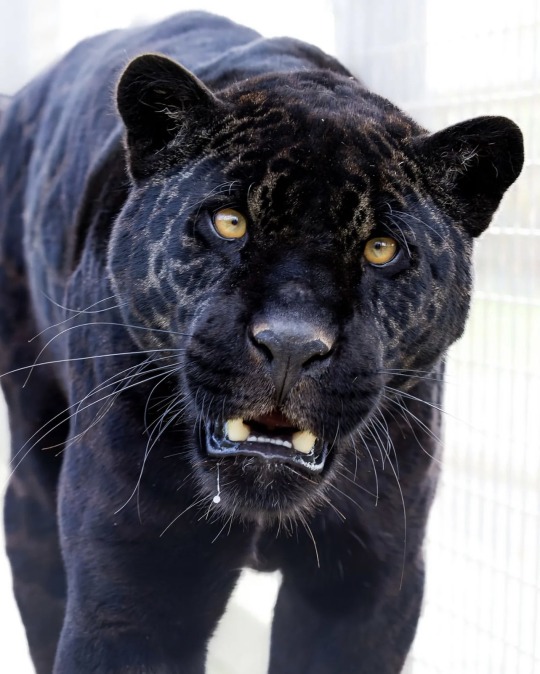
Inka on the prowl
Photographed by Ryan Stephens
Big Cat Sanctuary, Kent, England
166 notes
·
View notes
Text
@thebigcatsanctuaryuk
POV you're being stalked by Maya the black jaguar.
99 notes
·
View notes
Text
😻 Qara one of our cheeky Pallas's cats plays a game of hide and seek with our cameraman!
🧡 Pallas's cats are not the apex predator in their habitats so have had to adapt to be excellent hiders!
thebigcatsanctuaryuk
62 notes
·
View notes
Text
youtube
Meet Montana and Miles, learn their incredible story, and make your choice count.
Learn more about Turpentine Wildlife Refuge at https://www.turpentinecreek.org/
Find us on the following Social Media Channels & Pages
Facebook: https://www.facebook.com/TurpentineCreekWildlifeRefuge
Instagram: https://www.instagram.com/turpentinecreek/
LinkedIn: https://www.linkedin.com/company/turpentine-creek-wildlife-refuge/
#Youtube#tcwr#Turpentine creek#tigers#big cats#sanctuary#cute animals#wildlife#animals#critters#animal videos
4 notes
·
View notes
Text
HAPPY INTERNATIONAL LION DAY
This celebration was founded by Big Cat Rescue, the world’s largest accredited sanctuary dedicated to big cats.
Even though they are sometimes referred to as the 'king of the jungle', lions are under grave threat due to a number of man-made issues, including poaching and deforestation. The lion population is rapidly declining. Therefore to spread awareness about the lions and the issues faced by them World Lion Day is observed on August 10 every year.
Lion numbers have dramatically declined to the point where the species needs to be placed on the endangered list, just like its larger cousin the tiger.
According to the International Union for the Conservation of Nature, lions are a “vulnerable” species, meaning that their numbers could and should be higher. Currently, researchers estimate that there are between 30,000 and 100,000 lions left on planet Earth.
Over the course of five decades, the global lion population has decreased by about 90%.
The threats against lions are many: they face the dual specters of increasingly popular “trophy hunting” and human incursion on their traditional wildlands. A reduction in food combined with hunting tourism is making them more vulnerable with every passing year.
Raise awareness on Lion Day and the issues that the species faces in the wild, share photos of this big cat with your friends, support the protection of natural habitats.
Facts about lions
• While female lions perform the majority of the hunting, male lions guard the pride's territory. Nevertheless, the males always eat first.
• The most social of all the big cats, African lions live in packs called 'prides'. About 15 lions make up a pride.
• While a lion can run at 50 mph for short distances and leap 36 feet, its roar can be heard up to five miles away.
• The colour of a male lion's mane is a reliable indicator of his age. The older the lion, the darker his mane.
• Lions are the second-largest cat in the world, just behind the Asian tiger.
• Lions are typically found in grasslands and plains rather than the forests.
#lions#happy international lion day#animals#wild animals#animals video#lion#big cats#animalsanctuary#important#big cat#animal safety#lion day#support#animal sanctuary#world lion day
134 notes
·
View notes